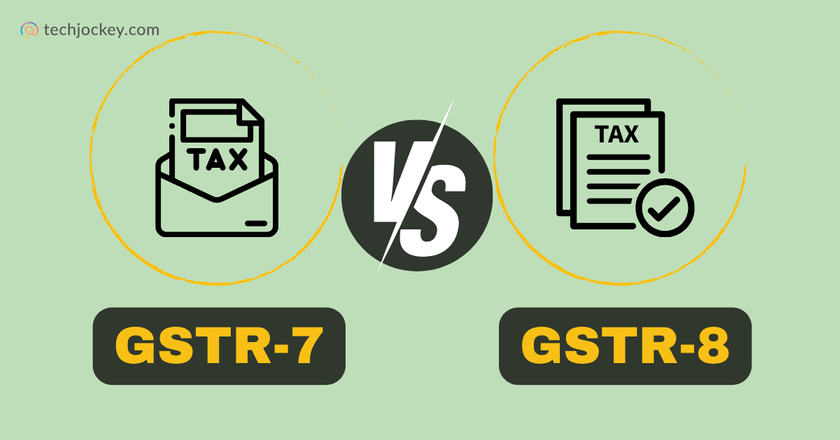Summary: GSTR-7 is filed by government and notified entities who deduct TDS under GST, whereas GSTR-8 is filed by e-commerce operators who collect TCS on behalf of sellers. Both are monthly compliance requirements with similar deadlines but different objectives.
There are multiple categories of GST returns in India. Two of them are GSTR-7 and GSTR-8, but these often confuse the taxpayers.
Although the terms involved, like TDS and TCS in each return are confusing, there is a lot of difference between GSTR-7 and 8.
Both terms are for different businesses. If it’s Tax Deducted at Source (TDS), or Tax collected at Source (TCS), you must be clear about which one applies to your business.
It could result in penalties if you mistakenly file the wrong form and it can also affect the input credit of the other party involved.
Let’s understand in detail the difference between GSTR-7 and 8.
What Is GSTR-7?
GSTR-7 is a monthly return that needs to be filed by people or organisations who deduct TDS under the GST system.
In simple words, if you’re buying goods or services and you’re required to deduct a certain percentage of tax before making the payment to your supplier, you need to file GSTR-7.
Who should file GSTR-7?
TDS under GST is mostly applicable to:
- Government departments
- Local authorities
- Public sector undertakings
- Agencies set up by the government
- Any other entity notified by the government
Let’s understand this with an example:
Suppose you have contractors or vendors serving you, and the contract value goes above INR 2.5 lakhs. In this case, if the vendor is registered under GST, you have to deduct TDS at 2% and report it through GSTR-7.
What does GSTR-7 include?
This return contains:
- Details of the suppliers from whom purchases were made
- The amount paid
- The tax deducted at source
- Payment of deducted TDS to the government
- Any late fees or interest (if applicable)
Once you have filed GSTR-7, the deducted TDS gets credited to the supplier’s electronic cash ledger. They can use it to pay their own GST dues.
Suggested Read: What is GSTR-7 & How to File GSTR – 7 Process Explained
What Is GSTR-8?
GSTR-8 is a return specifically for e-commerce operators. If you have an e-commerce platform where other sellers add their goods or services, you have to collect TCS on behalf of the sellers.
Who should file GSTR-8?
Only the e-commerce companies like Flipkart, Amazon, Zomato, etc. have to file GSTR-8.
If your business belongs to this category, you have to collect TCS; it’s usually 1% on the total value of taxable supplies through your platform.
What does GSTR-8 include?
This return captures:
- The GSTIN of the sellers using the platform
- Total sales made by each seller
- The amount of TCS collected
- The TCS paid the government
- Any corrections or amendments from previous months
Once you have filed GSTR-8, TCS will reflect in the seller’s electronic cash ledger and can be used to offset their GST liabilities.
Suggested Read: What is GSTR-8 & How to File GSTR-8 Process Explained
GSTR 7 vs GSTR 8: Key Differences
Here’s the difference between GSTR-7 and 8 explained in tabular format:
| Particulars | GSTR-7 | GSTR-8 |
|---|---|---|
| Applicable Return Type | Tax Deducted at Source (TDS) under GST | Tax Collected at Source (TCS) under GST |
| Filed By | Persons/entities required to deduct TDS under Section 51 of CGST Act | E-commerce operators required to collect TCS under Section 52 of CGST Act |
| Examples of Filers | Government departments, local authorities, notified public sector undertakings | Amazon, Flipkart, Swiggy, Zomato, UrbanClap, etc. |
| Nature of Tax Collected | TDS is deducted while making payment to suppliers | TCS is collected while receiving payment on behalf of suppliers |
| Tax Rate Applicable | 2% (1% CGST + 1% SGST) or 2% IGST | 1% (0.5% CGST + 0.5% SGST) or 1% IGST |
| Threshold Limit | TDS applicable if contract value > ₹2.5 lakhs (excluding GST) | No threshold; applicable on all taxable supplies through the platform |
| Purpose of Return | Report and deposit GST TDS deducted from payments to vendors | Report and deposit GST TCS collected from sales made on the platform |
| Details Required | – GSTIN of deductees – Payment amounts – TDS deducted – Refunds (if any) | – GSTIN of sellers – Net supplies – TCS collected – Returns/refunds |
| Due Date for Filing | 10th of the succeeding month | 10th of the succeeding month |
| Payment Due Date | Same as the return filing date (10th of the next month) | Same as the return filing date (10th of the next month) |
| Returns Not Filed Consequences | – Late fee – Interest on unpaid TDS – Blocking of credit to deductee | – Late fee – Interest on unpaid TCS – Sellers may not get credit timely |
| Late Filing Fee | ₹100 per day under CGST + ₹100 per day under SGST (max ₹5,000) | ₹100 per day under CGST + ₹100 per day under SGST (max ₹5,000) |
| Interest on Late Payment | 18% per annum on the delayed TDS payment | 18% per annum on the delayed TCS payment |
| Availability of Credit to Suppliers | Reflected in electronic cash ledger of the deductee (supplier) | Reflected in electronic cash ledger of the supplier |
| Amendment in Return | Can be rectified in future GSTR-7 filings | Can be rectified in future GSTR-8 filings |
| Relevant GST Section | Section 51 of CGST Act | Section 52 of CGST Act |
| Online Portal for Filing | GSTN Portal (https://www.gst.gov.in) | GSTN Portal (https://www.gst.gov.in) |
Why You Should File These Forms?
Filing GSTR-7 or GSTR-8 on time is more than just a compliance formality. It affects your suppliers and sellers directly.
- If you forget to file GSTR-7, your supplier won’t get the TDS credit, which can disrupt their working capital.
- If you delay GSTR-8, your sellers can’t claim the TCS you’ve collected, leading to cash flow issues and trust problems.
Moreover, GST authorities are quite strict with defaults. If they saw a continuous non-filing, they could send you legal notices or even cancel your GST registration.
Mistakes You Should Avoid
- Don’t add incorrect GSTINs: You must always check twice the GSTINs for suppliers or sellers before filing any GST return.
- Don’t select wrong return: Always make sure you select the right form and don’t get confused between GSTR-7 and 8.
- Double-check both amounts: This step is very important as wrong reconciliation between contract and invoice values could lead to discrepancies and penalties.
- Don’t miss amendments: If you revise a return for any month, don’t forget to reflect it in the next month’s GSTR filing.
Recent Improvements in GST Filing (As of FY 2025–26)
- Data is pre-filled now: The GST portal has now automated certain things. One includes filling data automatically based on past returns to save time.
- It offers matching tools: Suppliers and sellers can now reconcile TDS/TCS credits using GSTR-2B and dashboard reports.
- Error messages are now descriptive: Any errors while filing the form are now detailed so that users can fix issues faster.
Final Thoughts
It’s important to understand the difference between GSTR-7 and 8 if your business involves TDS or TCS. As discussed above, both terms seem similar, but actually they differ. Here’s a gist about the two terms:
- GSTR-7 is for those deducting TDS, and it’s for mostly government-related entities.
- GSTR-8 is for e-commerce platforms collecting TCS from sellers.
If you have any doubt while filing the return, we advise you to consult a GST practitioner or a CA. However, you can also use any GST software like ClearTax, Zoho Books, or TallyPrime to make the process simpler and easier.
Mehlika Bathla is a passionate content writer who turns complex tech ideas into simple words. For over 4 years in the tech industry, she has crafted helpful content like technical documentation, user guides, UX content, website content, social media copies, and SEO-driven blogs. She is highly skilled in... Read more









